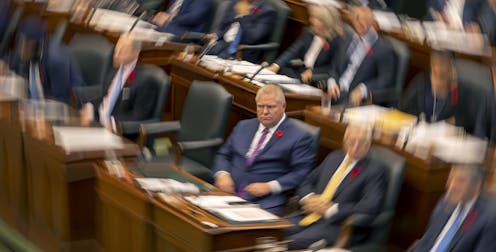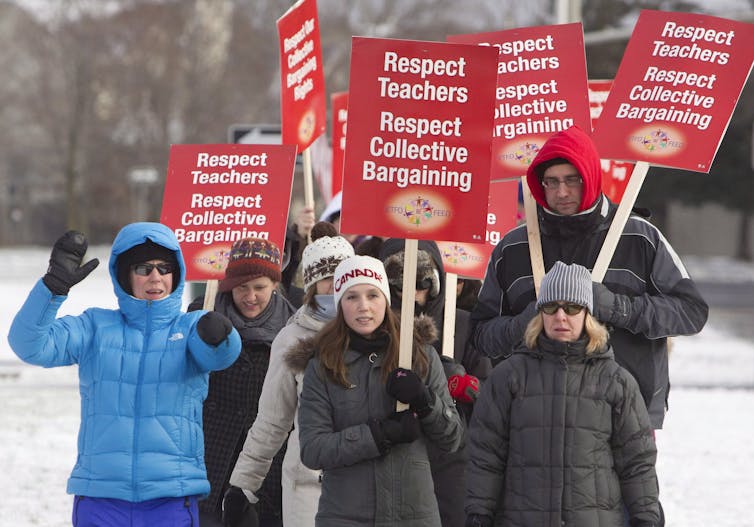
The government of Ontario has passed Bill 28 imposing a four-year contract on 50,000 education support workers and making it illegal to strike.
The back-to-work legislation affects educational assistants, early childhood educators, librarians, administrative staff and custodians represented by CUPE. It also invokes the so-called notwithstanding clause to insulate the government from future judicial scrutiny.
With its imposition of a contract upon these workers, and the Ontario government’s invocation of the notwithstanding clause in the Canadian Charter of Rights and Freedoms for the second time, there’s a lot to dissect in Bill 28.
Read more: Doug Ford uses the notwithstanding clause for political benefit
Back-to-work laws in a nutshell
Most unionized workers have both a statutory and — as of 2015 — a Charter right to strike in pursuit of a new collective agreement. Despite this, back-to-work legislation has been passed by governments of differing political stripes.
In their book From Consent to Coercion, political scholars Leo Panitch and Donald Swartz chronicled the increasing use of back-to-work legislation. They coined the term “permanent exceptionalism” to describe what they saw as governments consistently characterizing particular labour disputes as exceptional to justify back-to-work legislation, even while leaving intact the overriding law permitting the strike.
Panitch and Swartz argued that this was a way for governments to avoid political fallout from simply denying the right to strike outright. Instead, they do it by stealth — case-by-case as apparent one-offs.
But with the right to strike now afforded Charter protection, governments have to think about the legal fallout too. Bill 28, after all, bears many of the hallmarks of Ontario’s Putting Students First Act or Bill 115.
Bill 115 was passed in 2012 under the Liberal government of Dalton McGuinty. It, too, pre-empted an otherwise lawful strike amid negotiations with the province’s teachers. It also imposed a contract rather than leaving outstanding issues to a neutral third party.

It was deemed unconstitutional four years later, requiring the government to pay millions in damages to the workers whose Charter rights had been violated.
I have argued elsewhere that some back-to-work legislation is likely constitutional. But Bill 28 would almost assuredly be unconstitutional — except for the invocation of the notwithstanding clause.
Read more: Is back-to-work legislation unconstitutional?
Notwithstanding clause’s original aim
The notwithstanding clause, or Sec. 33 of the Charter, permits governments to pass laws “notwithstanding” that those laws violate specific provisions in the Charter.
At first glance, this is perplexing. Why adopt a constitutional Bill of Rights that can be ignored? However, at the time of the Charter’s creation, some provincial premiers were skeptical. They feared the dampening of their legislative supremacy via judicial overreach. Sec. 33 was the escape hatch offered to quell their fears.
Read more: The history of the notwithstanding clause
Québec had its own reasons for systematically attaching the clause to legislation in the Charter’s early days given that it was the only province not to have signed on to the Charter. Outside of that, however, Sec. 33 was rarely used in the first decades of the Charter — and doing so came to be understood by many as political suicide.
Its more recent invocation by governments in Ontario, Québec and Saskatchewan is concerning. Some fear it signals the move may soon become commonplace.
Additionally, its pre-emptive use, as is the case with Bill 28, is particularly indicative of constitutional recklessness.
The working presumption when the Charter was being hammered out is that legislatures want to protect their citizens’ rights. If true, it follows that the escape hatch of Sec. 33 is a device that should be used only after a law has been deemed unconstitutional.
This allows legislatures to review the courts’ rationales with consideration and thoughtfulness before determining whether they should proceed nonetheless, reserving Sec. 33’s use for exceptional circumstances.
The nuclear option?
There may be no cut-and-dried answer as to what may be deemed judicial overreach that warrants the use of Sec. 33.

But it’s perhaps noteworthy that former Saskatchewan premier Allan Blakeney, one of the most ardent critics of the adoption of the Charter at the time, was concerned about socially conservative judges undoing progressive social legislation.
This phenomenon was at play in the so-called Lochner era in the United States. What we would now consider basic employment standards laws were overturned on the basis that they contradicted the right of employers and employees to negotiate contracts.
Regardless of Blakeney’s views on the notwithstanding clause, it’s still hard to reconcile the initial purpose of Sec. 33 with its current potential use: to prevent 55,000 citizens, among the lowest-paid workers in Ontario’s education sector, to seek restitution for the violation of their Charter rights that Bill 28 would likely cause.
Whatever we might think about whether Ontario is justified in preventing the workers’ strike, neither the imposition of a collective agreement nor the invocation of Sec. 33 is necessary to meet the government’s stated goal of avoiding a labour disruption.
In fact, it may have upped the ante. In addition to a vow by CUPE to strike, others have pledged to walk off the job in solidarity.
It’s mostly been right-leaning provincial governments that have recently invoked Sec. 33. However, it bears noting that if we normalize its use, we normalize it for governments of all political stripes.
Labour relations on the brink
While most contract negotiations are settled without labour disruption, the threat of disruption is used as leverage by unions to move past impasses where they occur.
Ontario Superior Court Justice Thomas Lederer, in his decision on Bill 115, said the province’s labour relations are rooted in the notion that “the employer has power and the employee does not” and that “the ability of employees to act collectively” narrows that power gap.
Threats of labour disruption act to motivate the parties, usually in the days and hours leading up to a strike deadline, to reach a settlement neither party would propose but both can accept.
Ontario Education Minister Stephen Lecce’s stated refusal to even consider CUPE counter-offers unless it first calls off all job action is at odds with his stated intention to keep kids in school. It’s also at odds with the very heart of our labour relations model.
Alison Braley-Rattai does not work for, consult, own shares in or receive funding from any company or organisation that would benefit from this article, and has disclosed no relevant affiliations beyond their academic appointment.
This article was originally published on The Conversation. Read the original article.







